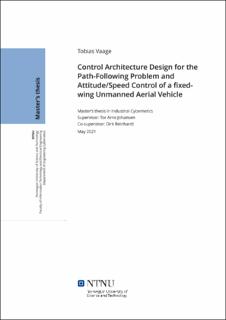| dc.contributor.advisor | Johansen, Tor Arne | |
| dc.contributor.advisor | Reinhardt, Dirk | |
| dc.contributor.author | Vaage, Tobias | |
| dc.date.accessioned | 2021-09-23T18:53:28Z | |
| dc.date.available | 2021-09-23T18:53:28Z | |
| dc.date.issued | 2021 | |
| dc.identifier | no.ntnu:inspera:76427839:47638531 | |
| dc.identifier.uri | https://hdl.handle.net/11250/2781064 | |
| dc.description.abstract | Ubemannede fly blir mer og mer autonome, og denne avhandlingen har som formål å belyse noen aspekter ved dette. Hovedoppgavene i denne avhandlingen baserer seg på identifisering av en matematisk modell for UAV, orienterings- og hastighets-regulering og hvordan "Gain scheduling" påvirker ytelsen til reguleringssystemene, og til slutt utviklingen av et banefølgingssystem. Identifikasjonsproblemet adresserer hvordan man kan finne et sett med aerodynamiske koeffisienter ved å bruke en metode som er omtalt som "Output-error method". Denne avhandlingen utvikler også diverse PID reguleringssystem for regulering av fart og orientering. Reguleringssystemene blir videre utvidet ved at man legger til "Gain scheduling", hvor forskjellene i ytelse blir studert i et casestudie. Styringsproblemet blir løst ved å ta i bruk en "Line-of-sight" (LOS) metode, hvor distansen mellom flyet og en bane blir minimert.
Metoden for systemidentifikasjon viste tvetydige resultater. Noen koeffisienter var vanskeligere å identifisere enn andre, mens de longitudinale koeffisientene generelt var vanskeligere å identifisere enn de laterale. Mens den laterale dynamikken med de identifiserte koeffisientene samsvarte med dynamikken med de sanne koeffisient-verdiene, klarte ikke det longitudinale systemet å simuleres med de identifiserte koeffisientene. Både det laterale og longitudinale reguleringssystemet klarte å regulere deres respektive domener. De består av pitch/høyde-, rull/kurs-, og hastighetsregulatorer, som er designet med variasjoner av PID regulering. Reguleringssløyfene ble utvidet med "Gain scheduling", noe som forbedret ytelsen ytterligere. Dette er spesielt tilfelle for den longitudinale dynamikken. "Gain scheduling" dempet bort uønskede svingninger, noe som førte til en mer stabil og presis flyvning. Banefølgingssystemet klarte å følge gitte veipunkter på en stabil og presis måte. Systemet virker meget sensitivt til innstillings-parameterene, noe som gjør systemet sårbart ved mer krevende veipunkter. Ved normal flyvning derimot, opererer systemet uten problemer. Banefølgingssystemet reduserer den menneskelige arbeidsmengden til å definere noen ønskede posisjoner i verden man ønsker at flyet skal fly gjennom. | |
| dc.description.abstract | Unmanned aerial vehicles (UAVs) are continuously becoming more autonomous, and this thesis aims to illuminate some aspects of this. The main objectives in this thesis are the identification of an aircraft model, airspeed and attitude control and how gain scheduling affects controller performance, and also deriving a path-following guidance system. The identification problem addresses how one can determine a set of aerodynamic coefficients by using the output-error method. This thesis also derives several PID control systems for control of airspeed and attitude. The control systems are extended by implementing gain scheduling, and the differences in performance are then studied further in a case study. The guidance problem is solved by using a Line-of-sight (LOS) method, where the distance between the aircraft and a desired path is minimized.
The system identification method showed ambiguous results. Some coefficients were easier to identify than others, and the longitudinal aerodynamic coefficients in general were harder to identify than the lateral coefficients. While the lateral dynamics with the identified coefficients was similar to the dynamics with the true coefficient values, the identified longitudinal coefficients rendered the dynamics unstable. Both the lateral and longitudinal control systems was able to control their respective domains. They consist of pitch/altitude, roll/course, and airspeed control, which are made of different variations of PID control. The control loops were extended by implementing gain scheduling, and the performance improved even further. That is especially true for the longitudinal dynamics. Gain scheduling did damp out unwanted oscillations, which lead to a more stable and accurate flight. The guidance system was able to follow the waypoints in a smooth and accurate manner. The system seems very sensitive to the tuning parameters, which exposes the system when the waypoints are not as easy to navigate through. However in nominal flight, the guidance system operates without issues. The system reduces the human workload down to determining positions in the world the aircraft is to fly through. | |
| dc.language | eng | |
| dc.publisher | NTNU | |
| dc.title | Control Architecture Design for the Path-Following Problem and Attitude/Speed Control of a fixed-wing Unmanned Aerial Vehicle | |
| dc.type | Master thesis | |
